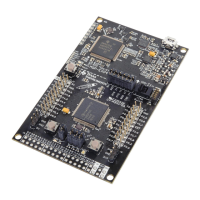(Optional) Lab 4c – Using Crystal Oscillators
(Optional) Lab 4c – Using Crystal Oscillators
1. Import lab_04a_clock_solution.
If you don’t remember how to do this, refer back to lab step 1 (on page 4-47).
2. Rename the project to lab_04c_crystals.
3. Make sure the project builds correctly.
4. Delete two files from the project:
• myClocks.c
• Old readme file (not required, but might make things less confusing later on)
5. Add files to project.
Add the following two files to the project:
• myClocksWithCrystals.c
• lab_04_crystals_readme.txt (again, not required, but helpful)
You’ll find them along the path
C:\msp430_workshop\
<target>\lab_04c_crystals\
6. Examine the new C file.
Notice the following:
• We need to “start” the crystal oscillators before selecting them as a clock source.
• Two different ways to “start” a crystal – with and without a timeout.
− If no timeout is used, then that function will continue until the oscillator is started. That
could effectively halt the program indefinitely, if there is a problem with the crystal
(say, it breaks, has a solder fault, or has fallen off the board).
− A better solution might be to specify a timeout … as long as you check for the result
after the function completes. (In our example, we just used an indefinite wait loop, but
“in real life” you might choose another clock source based on a failed crystal.)
7. Build to verify the file import was OK.
8. Add the following code to the initGpio() function in main.c.
Rather than having you build and run the project only to find out it doesn’t work (like what
happened to the course author), we’ll give you a hint: connect the clock pins to the crystals.
//Connect pins to crystal in/out pins
GPIO_setAsPeripheralModuleFunctionInputPin(
GPIO_PORT_P5,
GPIO_PIN5 + // XOUT on P5.5
GPIO_PIN4 + // XIN on P5.4
GPIO_PIN3 + // XT2OUT on P5.3
GPIO_PIN2 // XT2IN on P5.2
);
By default – on some MSP430 devices, such as the F5529 – these pins default to GPIO
mode. Thus, we have to connect them by reprogramming the GPIO.
4 - 58 MSP430 Workshop - MSP430 Clocks & Initialization

